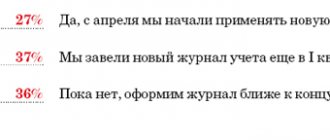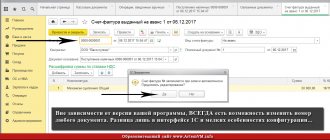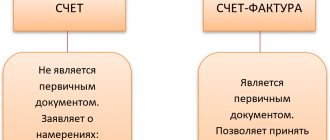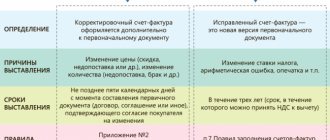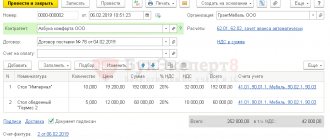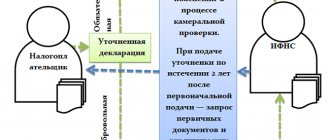New VAT from 2021 – 20 percent
Since 2004, the main VAT rate in Russia has been 18% (clause 11 of Federal Law No. 117-FZ dated July 7, 2003). However, Federal Law No. 303-FZ dated August 3, 2018 established a return to the VAT rate of 20% that applied before January 1, 2014.
The new VAT rate of 20 percent is effective from January 1, 2019.
The transition to a VAT rate of 20 percent will also include a change in the calculated rate. Thus, when receiving advances for upcoming sales, instead of the rate of 18/118, the rate of 20/120 will be applied.
See “ VAT rates from 2021: table ”.
Invoice from 01.10.2017
The second update of the invoice in 2021 brought several changes at once (Resolution of the Government of the Russian Federation dated August 19, 2017 N 981):
- a new column 1a “Product type code” has appeared. In it, Russian exporters of goods to the EAEU countries must indicate the code of the type of goods. Such a code is determined according to the unified Commodity Nomenclature of Foreign Economic Activity of the EAEU. If there is no need to fill out this column, a dash is placed in it;
- the words “(if available)” were added to the line “Identifier of government contract, agreement (agreement)”;
- Column 11 began to be called “Registration number of the customs declaration” (instead of “Customs declaration number”). Previously, it indicated the corresponding number for goods produced outside the Russian Federation. Now it must be filled out in relation to goods released by customs for domestic consumption in the territory of the SEZ in the Kaliningrad region;
- at the bottom of the invoice it is indicated that it is signed by an individual entrepreneur or other authorized person. That is, there should no longer be any controversy as to whether an entrepreneur can delegate his rights to sign invoices to someone else.
Similar changes were made to the adjustment invoice form. In addition, it is stipulated that additional information can be specified in additional lines of the adjustment invoice.
This form of invoice has been used since 10/01/2017.
Invoices can be submitted through the ConsultantPlus system.
New VAT documents
The increase in the VAT tax rate from 18 to 20 percent required changes in some documents that are drawn up when working with VAT. So, for example:
- changed the form of the sales book;
- adjusted the form of the journal of received and issued invoices;
- updated VAT return.
After the law on increasing VAT from 2021 was signed, many were interested: how will the invoice change from January 1, 2021?
So what changes in the invoice from July 19 are we talking about?
[email protected] came into force , which updated the electronic formats of the following documents important for VAT:
- invoices;
- adjustment invoice;
- UPD;
- document on the transfer of goods during trade operations;
- document on the transfer of work results (document on the provision of services).
The new formats take into account all the details that have appeared in the recent past and the latest changes related to VAT, including this year’s increase in the tax rate to 20%.
Thus, all you need to do to work correctly with invoices from July 19 is to update your software, for example, 1C, which the developers should have already updated. And in fact, this only applies to those who work with electronic documents. If all your documentation is paper, don’t bother yourself. And if on some sites you are offered to download a sample invoice from July 19, 2021, do not waste your time on this. Their sample is no different from a document you have been working with for a long time.
New or old invoice form in 2019?
Changes in filling out the invoice are related only to the increase in the value added tax rate from January 1, 2021.
Let us remind you that the rate at which the tax is calculated is reflected in column 7 of the form. In 2021, a new percentage is in effect - 20, so this particular rate will have to be shown instead of the previous 18 percent. However, the form itself must be taken from the already valid Government Decree dated December 26, 2011 No. 1137. No changes have been made to this document, therefore, from January 1, 2019, fill out the invoice on the “old” form.
Column 7 shows the VAT rate at which the tax is calculated. In the sample and new invoice form from January 1, 2021, in column 7, enter 20 percent instead of the usual 18.
Below is a sample of filling out an invoice in 2021, taking into account the new VAT rate:
Apply the new 20 percent VAT rate only to goods, works, services or property rights whose shipment date falls on or after January 1, 2021. The date of conclusion of the contract does not affect the rate. This procedure follows from paragraph 4 of Article 5 of the Law of August 3, 2018 No. 303-FZ.
Question: how can the buyer deduct VAT if he received an invoice for the 2021 shipment along with the goods later - in 2021
Answer: Deduct VAT at a rate of 18 percent.
At the time of shipment, this was the rate in effect. Therefore, you paid tax at this rate. We also received an invoice at a rate of 18 percent. It doesn’t matter that you received the goods at a time when another rate is already in effect. The new VAT rate of 20 percent applies only to goods, works, services or property rights, the date of shipment of which fell on the period from January 1, 2021.
Invoice 2021 for advance payment (during transitional times)
It is more difficult to understand when the process of “agreement - advance - sale” is extended during the period of transition to a higher tax rate. We present a table with various event options and their design:
| Situation | How to apply for a SF | |
| In 2018 | In 2019 | |
| Prepayment in full was transferred in 2021, goods and materials were shipped in 2019 | In the Northern Federation, VAT on advance payment is calculated at the rate of 18/118 | In the shipping SF, VAT is charged at 20%, but the tax on the advance amount is deducted 18/118 |
| Part of the payment was received in 2021, shipment - in 2021, the rest of the payment is transferred after shipment | Tax is reimbursed from the paid portion of the advance at the rate of 18/118. In the shipping SF, VAT is charged at 20% | |
So, to the price of goods and materials/services shipped from 01/01/2019, the seller adds VAT, calculated at a rate of 20% (letter of the Federal Tax Service No. SD-4-3 / [email protected] dated 10/23/2018).
There is a nuance here regarding the execution of the contract: if the amount of tax is not specified in it, for example, there is the phrase “the cost of the goods is 100 rubles. excluding VAT”, then the seller only needs to add 20% VAT to the cost of the goods and not make changes to the text and terms of the existing contract.
If the agreement specifies the cost of the goods with VAT of 18% (for example, o), then after shipment in the new year the parties need to reconsider the cost of delivery, recording this fact in writing. Moreover, regardless of whether the buyer agrees to increase the price of the goods or not, the supplier issues an invoice, indicating 20% VAT in it.
At the same time, if the cost of goods and materials is 100 rubles, and VAT until December 31, 2018 was 18 rubles, then when registering a shipping invoice in 2021. the tax amount will increase to 20 rubles. Depending on the agreements with the buyer, the seller will indicate in the SF:
- the previous cost of the goods (100 rubles) and increased VAT (20 rubles);
- or VAT 20% 19.67 rub. (118 x 20 / 120) and the adjusted price of goods and materials 98.33 rubles. (118 – 19.67).
VAT on advances before 01/01/2019 was accrued at the rate of 18/118, therefore, VAT refund on it upon shipment from 01/01/2019, and, accordingly, the restoration of VAT on prepayment issued, is carried out within the previously calculated amounts, i.e. at a rate of 18/118. It does not matter that shipments from 01/01/2019 are taxed at a rate of 20%. Since VAT 18% is valid until December 31, 2018, even if an advance is transferred to the supplier during this period, taking into account a 20% tax, he is obliged to charge VAT on the advance in the amount of 18%.
Rules for filling out invoices in 2019
The rules by which invoices must be filled out in 2021 are given in Government Decree No. 1137 dated December 26, 2011. These rules also did not change in any way in 2021 (this is logical, because the invoice form itself has not undergone amendments).
At the same time, we recall that the Tax Code of the Russian Federation has established a number of mandatory requirements for the preparation of invoices. They are contained in paragraphs 5, 5.1, 6 of Art. 169 of the Tax Code of the Russian Federation.
As a general rule, if the supplier does not indicate any of the required information when filling out an invoice or makes a mistake, the buyer will not be able to deduct the amount of VAT that he paid on such an invoice (Clause 2 of Article 169 of the Tax Code of the Russian Federation) .
If you receive an incorrect invoice from the seller, you have the right to ask the seller to make appropriate corrections.
A complete list of details that must be filled out in 2019 in the invoice for goods shipped, services provided, work performed or property rights transferred:
- serial number and date of compilation;
- name, address and identification numbers of the seller or contractor (taxpayer or tax agent) and buyer or customer;
- name and address of the shipper and consignee - only for shipped goods;
- number of the payment order or other payment and settlement document - if payment took place before shipment;
- the name of the goods shipped or a description of the work performed, services provided and property rights transferred, their units of measurement, when they can be determined;
- the quantity of goods shipped or the volume of work performed and services provided in the specified units of measurement, when they can be determined;
- name of currency;
- identifier of a government contract, contract (agreement) (if any) – for deliveries under government orders;
- price per unit of measurement, if possible, under the contract excluding tax. In case of application of state regulated prices - taking into account the amount of tax;
- the cost of goods shipped, work performed, services provided, transferred property rights without tax;
- the amount of excise duty on excisable goods;
- tax rate;
- the amount of tax based on current tax rates;
- the cost of the total quantity of goods supplied (shipped) according to the invoice (work performed, services rendered), transferred property rights, taking into account the amount of tax;
- country of origin of the goods - only for imported goods;
- registration number of the customs declaration - only for imported goods;
- code of the type of goods according to the Commodity Nomenclature of Foreign Economic Activity of the EAEU - when exporting goods to the countries of the Eurasian Economic Union.
Read also
20.09.2018
Invoice from 07/01/2017
First, a new indicator was added to the form of the invoice, as well as the adjustment invoice (Government Decree No. 625 of May 25, 2017). It is placed after the line “Currency: name, code” and is called “Identifier of government contract, agreement (agreement)”.
This line must be filled in when issuing an invoice within the following framework:
- government contract for the supply of goods (works, services);
- contracts (agreements) on the provision of subsidies, budget investments, contributions to the authorized capital from the federal budget.
Here you should indicate the identifier of such a contract or agreement (agreement) if an identifier is assigned.
Input VAT
If you paid for a product in 2021 and received it in 2019, you can deduct input VAT on the transferred advance payment at a rate of 18/118. After receiving the goods in 2021, reverse last year's deduction at the rate of 18/118 and claim a new deduction at the rate of 20%. After all, it is this VAT rate that will be highlighted by the seller in the invoice that you will receive from him in 2021.
If the goods were received from the seller in 2021 and paid for in 2019, deduct input VAT at a rate of 18%.


